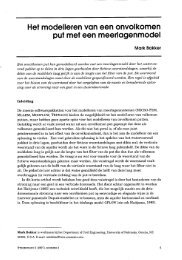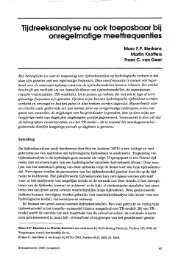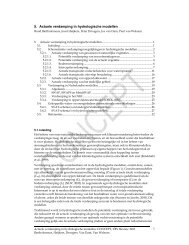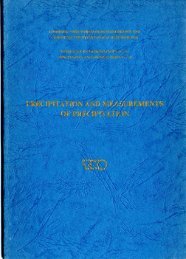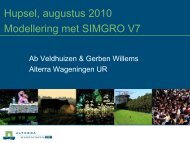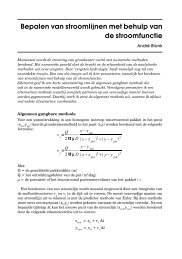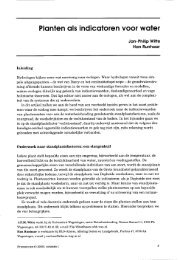Hydro-ecological relations in the Delta Waters
Hydro-ecological relations in the Delta Waters
Hydro-ecological relations in the Delta Waters
Create successful ePaper yourself
Turn your PDF publications into a flip-book with our unique Google optimized e-Paper software.
mudflats have retreated some 100-200 m with<strong>in</strong> 10 yeare (Van Otterloo.<br />
et al. 1987). Cenerally <strong>the</strong>se developments agree with <strong>the</strong> hypo<strong>the</strong>sized<br />
changes accord<strong>in</strong>g to Figure $B.<br />
Sedimentation of tke channels aa<strong>in</strong>ly is due to sand and mud transported<br />
by <strong>the</strong> rivers. The change <strong>in</strong> chnnel depth (Fig. 6) <strong>in</strong>dicates that <strong>the</strong><br />
channels .successively silt up frbm East co West. The siltation process<br />
will contfnue until all over <strong>the</strong> bas<strong>in</strong> a new equilibrium has been<br />
estahlibhed between <strong>the</strong> discharge volume and cross seotional area of<br />
<strong>the</strong> thannels.<br />
Erosion of <strong>the</strong> mudflats is caused by waves. Now that tidal waterlevel<br />
variations M longer exist, we attacks are concentrated <strong>in</strong> a narrow<br />
zone; at <strong>the</strong> same time this erosion no longer is compensated by<br />
sediments deposited by tidal currents dur<strong>in</strong>g high tides. The result is<br />
an <strong>in</strong>creased net erosion. Dnril 1988 <strong>the</strong> shore* of two areas (Beniager-<br />
and Korendijksche Slikkep) effectively have been protected aga<strong>in</strong>st<br />
erosion (Van Otterloo, et al. 19871. A progaam has been def<strong>in</strong>ed to<br />
protect all rema<strong>in</strong><strong>in</strong>g dais and raudflats before <strong>the</strong> year 1994.<br />
S<strong>in</strong>ce 197L tidal currents on Bar<strong>in</strong>golfet's ebb tidal delta ma<strong>in</strong>ly are<br />
detefn<strong>in</strong>ed hy <strong>the</strong> North - South directed tidal wave on <strong>the</strong> Narth Sea.<br />
East - West direefed tidal currents, previcusly flow<strong>in</strong>g <strong>in</strong>to and out of<br />
<strong>the</strong> estuaq, haoe reduced dramatically. Bluvial currents nowadays are<br />
restricted to periods around low water slack, when excess meter from<br />
Meuse and m<strong>in</strong>e is be<strong>in</strong>g discharged through <strong>the</strong> Har<strong>in</strong>gvliet sluices.<br />
Wave activity has not changed significantly over <strong>the</strong> last period.<br />
Accord<strong>in</strong>g t~ <strong>the</strong> hypo<strong>the</strong>ses of Section 2.2. a reduction <strong>in</strong> tidal velume<br />
of rhe estuary generally will <strong>in</strong>duce emsion of <strong>the</strong> ebb tidal delta and<br />
sedfmentgtion of <strong>the</strong> tidal channels. Obeervationa of geomorphological<br />
developmenrs s<strong>in</strong>ce L971 (Fig. 7) generally confirm this picture.<br />
ErosiQn of <strong>the</strong> ebb tidal delta is nest obvious aloqg <strong>the</strong> deltafront<br />
aroudd <strong>the</strong> NA? -5 m depth contour (Fig. 7). Here <strong>the</strong> landward directed<br />
Vdve '<strong>in</strong>duced sand transport no longer is cmpensated by sand traneport<br />
<strong>in</strong> a seaward direction <strong>in</strong>duaed by ebb tidal currents: <strong>the</strong> result is a<br />
net erosien of <strong>the</strong> deltafront. The eroded sediments are deposited





